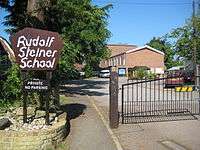Rudolf Steiner School Kings Langley

Rudolf Steiner School Kings Langley is a Steiner School located in Kings Langley, Hertfordshire, England, formed in 1949.
The school caters for pupils aged 3 to 19 years old, and has a capacity of 440 pupils.
The School is set on 10 acres (40,000 m2) of grounds, on the site of Kings Langley Palace, a 13th-century Plantagenet royal palace.
History of the school
The grounds are on the site of the medieval Dominican Priory of Kings Langley. The school was incorporated in its present form offering Waldorf education in 1949 and was at that time called the New School. A private school had existed on this site since around 1909 and was known as Coombe Hill School or Priory School.[1] The headmistress, Margaret Cross, was interested in progressive ideas in education and in 1921 attended a course run by Dr. Rudolf Steiner, who visited the school himself in April 1922. From then on elements of Steiner's educational method such as bio-dynamic gardening and eurythmy were included in the curriculum.[1] The school became fully committed to the Steiner method in 1949. The main school block was built in stages between 1955–75, the dining room and theatre added in 1969-71 and the sports hall in 1970. The kindergarten was built on the edge of the grounds near Friarswood in 1966 and the Pottery, was opened in 1991.[2]
The three stages of Steiner education at the school
There are three stages to any Steiner education: kindergarten, lower school and upper school.
There are two Kindergartens at Rudolf Steiner Kings Langley School, both of which are in a separate area from the main school building. This is where children from 3 years of age to 5 years spend their day. Kindergarten is like an extended playgroup. During the day the children play games, do creative activities and go on short walks in the school grounds.
The lower school consists of classes 1 to 8. There is one class per year with roughly 25 students in each class. The years are academically one year behind the average state school, for example children in class six would be in year seven at a state secondary school.
Writing and reading skills are developed during classes 1 and 2. French and German are also introduced at this time through songs and games. Creativity is still being developed in the children at this stage. They start handwork where they learn to knit, perform a play during the course of the year, and work outside in the gardening lesson. Another subject they start is Eurythmy, which is a way of telling stories through body movement.
More solid subjects such as Mathematics, English Literature, History, Geography, Religion and the Sciences are introduced in the middle school from class 3 to 8. During this period no exams on these subjects take place.
The upper school is from class 9 to 13. The Steiner Schools GCSE examinations are started a year later than state schools to give the students in class 9 the opportunity to go on a French or German exchange for a term. This is recommended as it enhances their understanding of the language. Therefore GCSEs are taken in class 11 and A-levels are taken in class 13.
Steiner education is not just about the academic ability of the child but developing their creative skills, too. As the Rudolf Steiner Kings Langley School motto emphasises, “Education for Head, Heart, and Hand”.
School Lessons
The Waldorf curriculum offers many subjects which are not usually included in state schools. These subjects are main lesson, gardening, handwork, pottery, woodwork, metalwork, painting and drawing, sponsor lesson and Eurythmy.
Main Lesson is usually the first lesson of the day for all classes, up until class 12, which covers a number of different topics depending on which class you attend. A typical main lesson could last about 2–4 weeks. Gardening is an outdoor lesson which introduces some agricultural education into the school's curriculum. This lesson is done from classes 3 to 6. Handwork is part of the craft lessons, and teaches young students how to knit, crochet and varied forms of sowing. This lesson is introduced to classes 1 to 8. Pottery is an art lesson where pupils can learn how to work with clay and design ceramic projects. The school has its own separate building for this subject which also houses a kiln. Pottery is introduced from class 4. Woodwork and Metalwork are both lessons where pupils can develop their practical skills using hand and machine tools. Metal work contains more hazardous machines, so it is only introduced from class 9 onwards. Painting and drawing are introduced to pupils from a young age. In the higher classes, more materials are introduced like acrylic and oil paints, charcoal and pastels.
Sponsors
Sponsors are ordinary teachers who are assigned to supervise an upper school class from classes 9 to 13. There can be up to two sponsors per class. The sponsor lessons are only for the upper school and pupils discuss any issues or questions with their sponsor. Click the link for Eurythmy.
Inspections
The school has had four inspections by the School Inspection Service from March 2015 to June 2016. The inspectors have written: "The school has not investigated either fully or impartially important matters that were raised by parents nor considered them in the broader context of risk to children."
References
- 1 2 Coombe Hill School, Kings Langley at Hertfordshire Genealogy. Accessed September 2013
- ↑ History of School at RSSKL website. Accessed September 2013
External links
- Rudolf Steiner School Kings Langley official website
- Coombe Hill School, later Priory School, Kings Langley
Coordinates: 51°42′43″N 0°27′32″W / 51.71194°N 0.45889°W